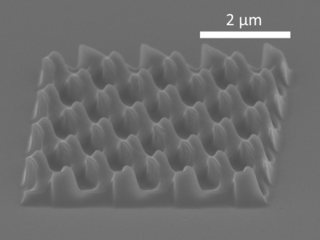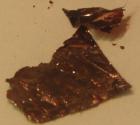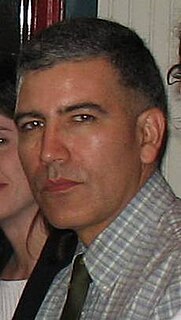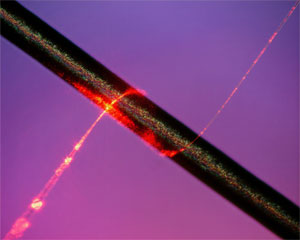Related Research Articles
A nanowire is a nanostructure, with the diameter of the order of a nanometre (10−9 meters). It can also be defined as the ratio of the length to width being greater than 1000. Alternatively, nanowires can be defined as structures that have a thickness or diameter constrained to tens of nanometers or less and an unconstrained length. At these scales, quantum mechanical effects are important—which coined the term "quantum wires". Many different types of nanowires exist, including superconducting (e.g. YBCO), metallic (e.g. Ni, Pt, Au, Ag), semiconducting (e.g. silicon nanowires (SiNWs), InP, GaN) and insulating (e.g. SiO2, TiO2). Molecular nanowires are composed of repeating molecular units either organic (e.g. DNA) or inorganic (e.g. Mo6S9−xIx).
Optical tweezers are scientific instruments that use a highly focused laser beam to hold and move microscopic and sub-microscopic objects like atoms, nanoparticles and droplets, in a manner similar to tweezers. If the object is held in air or vacuum without additional support, it can be called optical levitation.

A nanoparticle or ultrafine particle is usually defined as a particle of matter that is between 1 and 100 nanometres (nm) in diameter. The term is sometimes used for larger particles, up to 500 nm, or fibers and tubes that are less than 100 nm in only two directions. At the lowest range, metal particles smaller than 1 nm are usually called atom clusters instead.

Nanoimprint lithography (NIL) is a method of fabricating nanometer scale patterns. It is a simple nanolithography process with low cost, high throughput and high resolution. It creates patterns by mechanical deformation of imprint resist and subsequent processes. The imprint resist is typically a monomer or polymer formulation that is cured by heat or UV light during the imprinting. Adhesion between the resist and the template is controlled to allow proper release.
Nanophotonics or nano-optics is the study of the behavior of light on the nanometer scale, and of the interaction of nanometer-scale objects with light. It is a branch of optics, optical engineering, electrical engineering, and nanotechnology. It often involves dielectric structures such as nanoantennas, or metallic components, which can transport and focus light via surface plasmon polaritons.
A fiber laser is a laser in which the active gain medium is an optical fiber doped with rare-earth elements such as erbium, ytterbium, neodymium, dysprosium, praseodymium, thulium and holmium. They are related to doped fiber amplifiers, which provide light amplification without lasing. Fiber nonlinearities, such as stimulated Raman scattering or four-wave mixing can also provide gain and thus serve as gain media for a fiber laser.
Silicon photonics is the study and application of photonic systems which use silicon as an optical medium. The silicon is usually patterned with sub-micrometre precision, into microphotonic components. These operate in the infrared, most commonly at the 1.55 micrometre wavelength used by most fiber optic telecommunication systems. The silicon typically lies on top of a layer of silica in what is known as silicon on insulator (SOI).

In optics, a supercontinuum is formed when a collection of nonlinear processes act together upon a pump beam in order to cause severe spectral broadening of the original pump beam, for example using a microstructured optical fiber. The result is a smooth spectral continuum. There is no consensus on how much broadening constitutes a supercontinuum; however researchers have published work claiming as little as 60 nm of broadening as a supercontinuum. There is also no agreement on the spectral flatness required to define the bandwidth of the source, with authors using anything from 5 dB to 40 dB or more. In addition the term supercontinuum itself did not gain widespread acceptance until this century, with many authors using alternative phrases to describe their continua during the 1970s, 1980s and 1990s.

Gallium(II) selenide (GaSe) is a chemical compound. It has a hexagonal layer structure, similar to that of GaS. It is a photoconductor, a second harmonic generation crystal in nonlinear optics, and has been used as a far-infrared conversion material at 14–31 THz and above.

Francisco Javier "Frank" Duarte is a laser physicist and author/editor of several well-known books on tunable lasers and quantum optics. He introduced the generalized multiple-prism dispersion theory, has discovered various multiple-prism grating oscillator laser configurations, and pioneered polymer-nanoparticle gain media. His contributions have found applications in a variety of fields including astronomical instrumentation, atomic vapor laser isotope separation, geodesics, gravitational lensing, laser medicine, laser microscopy, laser pulse compression, laser spectroscopy, nonlinear optics, and tunable diode lasers.

A subwavelength-diameter optical fibre is an optical fibre whose diameter is less than the wavelength of the light being propagated through it. An SDF usually consists of long thick parts at both ends, transition regions (tapers) where the fibre diameter gradually decreases down to the subwavelength value, and a subwavelength-diameter waist, which is the main acting part. Due to such a strong geometrical confinement, the guided electromagnetic field in an SDF is restricted to a single mode called fundamental.
The Mamyshev 2R regenerator is an all-optical regenerator used in optical communications. In 1998, Pavel V. Mamyshev of Bell Labs proposed and patented the use of the self-phase modulation (SPM) for single channel optical pulse reshaping and re-amplification. More recent applications target the field of ultrashort high peak-power pulse generation.

A photonic metamaterial (PM), also known as an optical metamaterial, is a type of electromagnetic metamaterial, that interacts with light, covering terahertz (THz), infrared (IR) or visible wavelengths. The materials employ a periodic, cellular structure.
A plasmonic-enhanced solar cell, commonly referred to simply as plasmonic solar cell, is a type of solar cell that converts light into electricity with the assistance of plasmons, but where the photovoltaic effect occurs in another material.

Solid-state dye lasers (SSDL) were introduced in 1967 by Soffer and McFarland. In these solid-state lasers, the gain medium is a laser dye-doped organic matrix such as poly(methyl methacrylate) (PMMA), rather than a liquid solution of the dye. An example is rhodamine 6G-doped PMMA. These lasers are also referred to as solid-state organic lasers and solid-state dye-doped polymer lasers.
A plasmonic metamaterial is a metamaterial that uses surface plasmons to achieve optical properties not seen in nature. Plasmons are produced from the interaction of light with metal-dielectric materials. Under specific conditions, the incident light couples with the surface plasmons to create self-sustaining, propagating electromagnetic waves known as surface plasmon polaritons (SPPs). Once launched, the SPPs ripple along the metal-dielectric interface. Compared with the incident light, the SPPs can be much shorter in wavelength.
Photon etc. is a Canadian manufacturer of infrared cameras, widely tunable optical filters, hyperspectral imaging and spectroscopic scientific instruments for academic and industrial applications. Its main technology is based on volume Bragg gratings, which are used as filters either for swept lasers or for global imaging.
Photonic molecules are a theoretical natural form of matter which can also be made artificially in which photons bind together to form "molecules". They were first predicted in 2007. Photonic molecules are formed when individual (massless) photons "interact with each other so strongly that they act as though they have mass". In an alternative definition, photons confined to two or more coupled optical cavities also reproduce the physics of interacting atomic energy levels, and have been termed as photonic molecules.
Juerg Leuthold is a full Professor at ETH Zurich, Switzerland.

Coherent Raman scattering (CRS) microscopy is a multi-photon microscopy technique based on Raman-active vibrational modes of molecules. The two major techniques in CRS microscopy are stimulated Raman scattering (SRS) and coherent anti-Stokes Raman scattering (CARS). SRS and CARS were theoretically predicted and experimental realized in the 1960s. In 1982 the first CARS microscope was demonstrated. In 1999, CARS microscopy using a collinear geometry and high numerical aperture objective were developed in Xiaoliang Sunney Xie's lab at Harvard University. This advancement made the technique more compatible with modern laser scanning microscopes. Since then, CRS's popularity in biomedical research started to grow. CRS is mainly used to image lipid, protein, and other bio-molecules in live or fixed cells or tissues without labeling or staining. CRS can also be used to image samples labeled with Raman tags, which can avoid interference from other molecules and normally allows for stronger CRS signals than would normally be obtained for common biomolecules. CRS also finds application in other fields, such as material science and environmental science.
References
- ↑ Urban, Alexander S.; Lutich, Andrey A.; Stefani, Fenando D.; Feldmann, Jochen (2010). "Laser Printing Single Gold Nanoparticles" (Free PDF download). Nano Letters. 10 (12): 4794–8. Bibcode:2010NanoL..10.4794U. doi:10.1021/nl1030425. PMID 20957994.
- ↑ Nedev, Spas; Urban, Alexander S.; Lutich, Andrey A.; Feldmann, Jochen (2011). "Optical Force Stamping Lithography" (Free HTML download from NIH.gov). Nano Letters. 11 (11): 5066–70. Bibcode:2011NanoL..11.5066N. doi:10.1021/nl203214n. PMC 3833036 . PMID 21992538.
- ↑ Zywietz, Urs; Evlyukhin, Andrey B.; Reinhardt, Carsten; Chichkov, Boris N. (2014). "Laser printing of silicon nanoparticles with resonant optical electric and magnetic responses". Nature Communications. 5: 3402. Bibcode:2014NatCo...5.3402Z. doi: 10.1038/ncomms4402 . PMID 24595073.
- ↑ Masui, Kyoko; Shoji, Satoru; Asaba, Kenji; Rodgers, Thomas C.; Jin, Feng; Duan, Xuan-Ming; Kawata, Satoshi (2011). "Laser fabrication of Au nanorod aggregates microstructures assisted by two-photon polymerization" (Free PDF download). Optics Express. 19 (23): 22786–96. Bibcode:2011OExpr..1922786M. doi: 10.1364/OE.19.022786 . PMID 22109158.